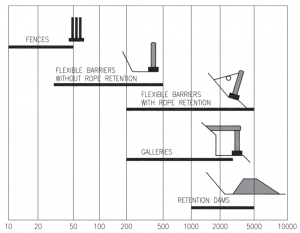Rockfall hazards pose a significant threat to infrastructure and settlements in mountain regions around the world. These natural occurrences, where detached rock masses break free and careen downslope, can have devastating consequences if not properly mitigated. Understanding the dynamics of rockfall is crucial in developing effective protective measures.

The motion of a falling rock block can be divided into several distinct modes: sliding, rolling, toppling, inclined, and impact upon reaching the ground. The specific trajectories, impact energy, and bouncing height are influenced by the slope geometry, surface characteristics, and the inherent properties of the rock block itself, such as weight and shape.
Rockfall as a distinct engineering challenge gained prominence with the advent of railway construction in the mid-19th century. Early mitigation systems consisted of rigid structures, such as steel rails, wooden beams, and earth walls. However, as the understanding of rockfall dynamics advanced, a new generation of flexible rockfall barriers emerged.
Rockfall barriers represent a versatile and highly effective protection system. These flexible structures are designed to deform upon impact, gradually dissipating the energy of the falling rock through their braking mechanisms. Imagine throwing a tennis ball at a curtain – the fabric would absorb the impact, slowing the ball’s momentum.
Rockfall barriers are composed of several key elements:
- Foundations: Providing a sturdy base for the barrier system.
- Anchors: Securing the barrier to the surrounding terrain.
- Base Plates: Distributing the forces evenly across the foundation.
- Posts: Offering vertical support for the barrier structure.
- Intermediate and Lateral Support Ropes: Maintaining the barrier’s shape and stability.
- Bearing Mesh: Catching and decelerating the falling rock.
- Brake System: Gradually dissipating the impact energy.
Rockfall barrier systems must meet stringent performance standards to ensure their effectiveness. The European Technical Approval (ETA-12/0213) by Geobrugg AG’s GBE-8000A rockfall barrier, certified by all EOTA members, is a legally binding proof of compliance with the ETAG 027 (European Technical Approval Guideline) requirements.
Evaluating the risk of rockfall and determining the appropriate rockfall barrier system requires a comprehensive approach, including detailed calculations and simulations.

Rockfall simulations are conducted on characteristic cross-sections of the slope, using specialized computer programs. These simulations model the trajectory, bouncing height, and energy impact of the falling rock, providing crucial data for the design of passive protection measures.
One of the key input parameters for the rockfall simulation is the size and shape of the rock block. To accurately define these parameters, detailed engineering geological mapping, often conducted by specialized alpinist geologists, is necessary.

It’s important to acknowledge that rockfalls are inherently natural phenomena, and their behavior cannot be predicted with 100% accuracy. Simulations provide approximate values, and real-world conditions may vary. Maintaining a realistic perspective on the limitations of these tools is essential for effective rockfall protection planning.
Croatia has witnessed the successful implementation of several rockfall barrier projects, showcasing the engineering prowess in addressing this challenge. Notable examples include the barriers installed in Omiš, Raspadalica, Brzet, Katarina, and along major highways.
Rockfall barriers represent a dynamic and evolving field of rock mass mechanics, where engineers and researchers continue to push the boundaries of innovation. As we navigate the complexities of protecting infrastructure and settlements in mountain regions, the advancement of rockfall barrier technology will remain a crucial focus for the years to come.


